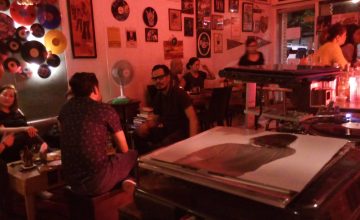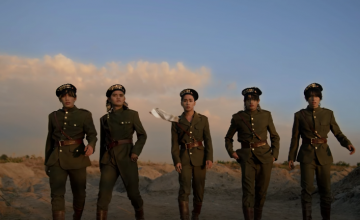On today’s episode of Nobody Asked But I’ll Share It Anyway, I found a new social app to be obsessed with: Quora. FYI, it’s a forum platform where you can publish any question—even the most random and silliest ones you didn’t think would have proper answers to—and let people give their insights on it.
It’s been a hot minute since I’ve scrolled through social media without feeling the urge to pull my hair out or throw my phone across the room, so I was pleasantly surprised by how fun Quora is. Reading unserious questions (“Would you rather get hit over the head with a giant dildo, a shovel, or a glass bottle?”) get equally unserious answers (“Dildo. I’d find it mentally stimulating.”) makes a great pastime, especially when other apps get a bit too toxic.
Today was different, though. Instead of scouring the humorous (low-key NSFW) side of the platform like usual, I decided to peep at its existential crisis-prone section and came across a Q that had me using my last two brain cells: “If you could time-travel to any year, future or past, which year would you choose and why?”
While the local music industry in the late ’90s was relatively dominated by pop rock bands (heavy on Eraserheads) and solo ballad acts, one particular girl group—with their novelty sound and easy-to-follow dance routine—provided a refreshing take on Pinoy pop
Should I choose a historical year and make my own little Klay Infantes (hi, “Maria Clara at Ibarra” and FiLay enjoyers) moment? Go to the far future and see if I’d become a millionaire? Or simply rewind last night to stop my acidic self from downing a can of cola? The possibilities were endless, but after careful contemplation, I finally decided on a year: 1999. And for good reason.
Besides the fact that it was the year I was born (and I’d very much like to un-born myself), it was also the birth of what would be called the “OG nation’s girl group” in the coming years. While the local music industry in the late ’90s was relatively dominated by pop rock bands (heavy on Eraserheads) and solo ballad acts, one particular girl group—with their novelty sound and easy-to-follow dance routine—provided a refreshing take on Pinoy pop.
Fast forward to more than two decades later, the entertainment landscape has undergone a drastic transformation: P-pop groups are steadily taking over and revolutionizing the scene. But how exactly did we get here? Let’s take a retrospective look into the P-pop herstory and the transformation of local girl groups throughout the years.
Early 2000s: The SexBomb Girls domination
Although the SexBomb Girls (formerly called Chicken Sandwich Dancers) were already established as segment dancers for the noontime variety show “Eat Bulaga!” in 1999, it wasn’t until the early 2000s that they entirely dominated the local entertainment scene. They officially “debuted” in 2002 with over 20 members—the majority of whom were selected from dance searches.
At that time, they were everywhere: in various TV programs, mall shows, advertisements, political campaigns, comedy bars… you name it. Their albums (which achieved 5x platinum at best) and easy-to-follow choreographies became a massive hit among the masses, and they even had their own afternoon anthology series (which ran for 26 seasons) called “Daisy Siete.”
The SexBomb Girls were a cultural phenomenon that if I were to play their iconic “The Spageti Song” in a room full of Filipinos, I bet my entire paycheck everyone—irrelevant of their age or gender—would sing and dance along. Their songs remain staples in local events and parties, with many people, especially on social media, not letting the group’s legacy die by making viral edits. (Heck, even a huge streaming platform got the girls for a promotional dance performance in 2023.)
They were the epitome of a P-pop girl group long before the term even became colloquial. They arguably set the foundation and have become the formula inspiration for many groups that followed: Viva Hot Babes, Mocha Girls, and EB Babes, to name a few.
Late 2000s to mid-2010s: The era of unsuccessful debuts
Considering the huge success of the SexBomb Girls, one would think that it would be easier for succeeding girl groups to penetrate the mainstream. Unfortunately, it didn’t pan out that way. The late 2000s to mid-2010s witnessed a slew of all-female groups debuting, only to fade into obscurity not long after.
Among the most notable groups during this era was Pop Girls, which was introduced to the public in 2009. They were composed of five members, each having the star factor to make it big, but despite the solid potential, the group struggled to take off. Their debut song “Crazy Crazy” was an absolute bop that I personally think deserved more recognition than it got; It was catchy, upbeat, and reminiscent of the most popular K-pop songs in the country at that time.
But perhaps the issue lies in this very resemblance: Many Filipinos had a hard time embracing a local girl group that was branded a tad too much like Korean idols. Some called them “copycats” while others simply couldn’t wrap their heads around the K-pop influence.
Other girl groups that debuted during this period included Sugar ’n Spice, U Go Girls, and CH4RMD (which was later rebranded as Charmed). Each had their own unique sound and concept, but they all shared the same fate of being unable to sustain their careers and eventually disbanding.
Mid to late 2010s: The (slow but steady) rise of P-pop girl groups
Just when it seemed like the P-pop girl group scene was headed towards a permanent slump, 4th Impact gave it a much-needed boost. The quartet (consisting of biological sisters Almira, Irene, Mylene, and Celina) initially gained attention when they joined “Protégé: Battle for the Big Break” (Philippines) and “Superstar K6” (South Korea). But they ultimately rose to fame after auditioning for “The X Factor (UK)” in 2015, where they placed fifth overall.
Their rendition of Jessie J’s “Bang Bang” became a viral hit and was shared by millions across various platforms. They also co-headlined The X Factor Live Tour, showcasing the group’s performance prowess and making it known that P-pop female acts weren’t to be underestimated.
After conquering the international stage, 4th Impact returned to Manila and was able to somehow carve out a niche in the local scene. They dropped their first digital single “Unleash the Diva” in 2017, which peaked at #3 on iTunes PH and #1 at Spotify Viral 50 PH.
A year later, an all-Filipina P-pop group was formed through the franchise system of AKB48—a massive Japan-based girl group known for their unique “idols you can meet” concept. MNL48 pushed through with the same approach and debuted with “Aitakatta (Gustong Makita).”
While some appreciated the refreshing change in the local music scene, many had difficulties resonating with a P-pop girl group that seemed too heavily influenced by their Japanese counterparts (to be fair, that was literally the point of the franchise). But despite the polarized reactions, MNL48 gained quite a following over the years through several releases and concert/festival performances both in and out of the country.
I’d like to believe, though, that the group would’ve been so much bigger if they were given more original tracks—not just direct translations of their sibling group’s existing songs—and were promoted more vigorously. But hey, that’s a conversation for another day.
2019 to present: The renaissance (a.k.a. the P-pop explosion)
Finally. After decades of simmering and building up momentum, the P-pop genre has reached its tipping point and exploded into the mainstream in the early 2020s. The local music scene has never been more vibrant (and diverse) than it is now, thanks to the emergence of groups that have been taking cues from K-pop and giving them a distinctly Filipino twist.
Leading the pack was SB19—a five-member P-pop group signed under a South Korean entertainment agency that underwent the infamous K-pop training system. Although (obviously) not a girl group, their rise to fame was instrumental in putting P-pop on the map and paving the way for others to follow suit. (ICYDK, they’re the first Filipino act to enter Billboard’s Social 50 chart.)
Zeroing in on the girl group category, among the biggest names in P-pop today are BINI, KAIA, G22, SB19’s sibling group YGIG, and YARA. These groups are ceaselessly making a splash with their catchy tunes, polished dance moves, and visually stunning music videos. They’re setting the bar high in their own right—each carrying a distinct sound and personality that set them apart from their predecessors and contemporaries.
BINI, in particular, has been playing an integral role in destigmatizing bubblegum pop and proving that it’s a genre to be taken seriously. Their ear-candy singles “Lagi” and “Na Na Na” instantly rocketed to virality—to date, they already racked up over a million views on YouTube and have been used as TikTok sounds more than 500,000 times.
Meanwhile, KAIA, G22, YGIG, and YARA all have their fair share of empowering tracks. KAIA’s “5678” is a fiery declaration of never giving up on dreams, G22’s “Bang!” and YGIG’s “Shaba Shaba” serve as anthems of self-assured women, while YARA’s “ADDA” is a nod to powerful female friendships.
It isn’t just about music now, though—these girl groups are also providing us with some major style inspo. They’ve been influencing local pop culture with their iconic looks that range from chic and sophisticated to edgy and daring.
Looking back, it’s clear that P-pop has come a long way since the days of the SexBomb Girls. While they were undoubtedly pioneers, today’s girl groups have taken the blueprint and elevated it to new heights. With their talent, passion, and unwavering dedication, these women are breaking boundaries and cementing P-pop as a cultural mainstay. So, here’s to the present (and future) generation of local girl groups—more chart-topping hits, more slay™ fashion moments, and more milestones to be celebrated.
Read more:
For P-pop artists, fans hold the future of the genre
Bubblegum P-pop is rising from the dead, thanks to BINI
Bless your ears with this ‘yassified estetik’ version of Nadine Lustre’s ‘Paligoy-ligoy’
Art by Yel Sayo
Photos from ABS-CBN Music, YGIG’s Instagram, and the Sexbomb Girls’ “Unang Putok” album shoot
























Comments